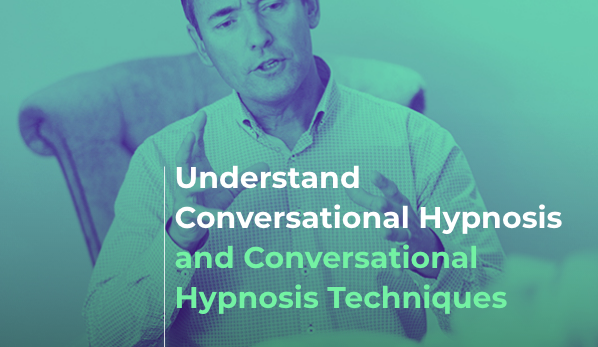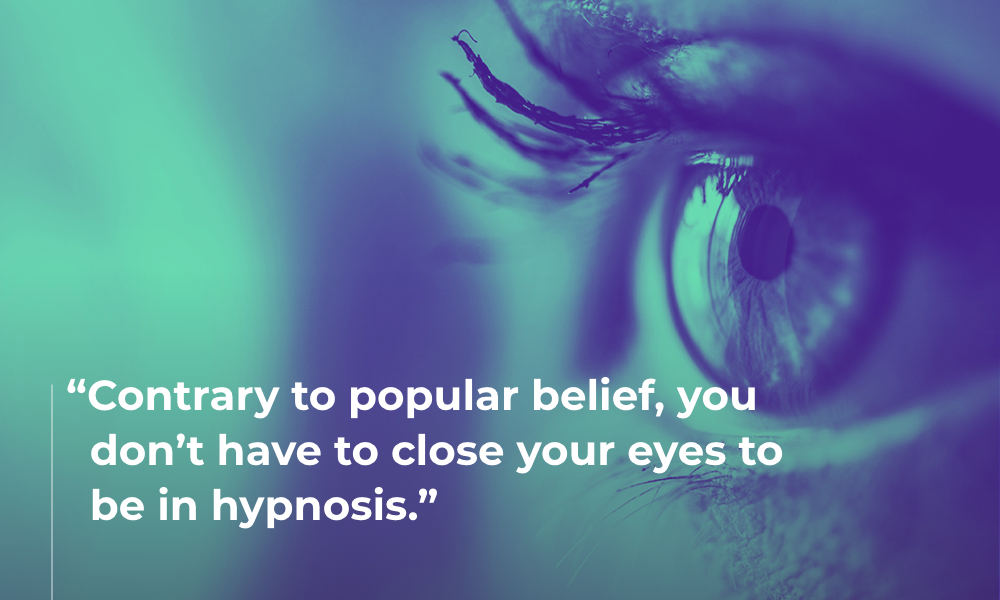What is conversational hypnosis? And how does it work?
Conversational hypnosis is a broad term that gathers a variety of techniques under one umbrella. They have a different style than traditional hypnosis methods, and that’s why hypnotists put them into their own separate category. Conversational techniques are simply tools that a hypnotist uses to help people make profound changes in their lives.
Read on to discover what conversational hypnosis is, its techniques, and how it can help you.
What Is Conversational Hypnosis?
In other types of hypnosis, a hypnotherapist directly guides you into a trance. Then you receive hypnotic suggestions that speak directly to your unconscious mind. They tell your mind how to make changes in your life, often by altering habits, beliefs, and other mental patterns that are holding you back.
Everyone who seeks out hypnotherapy wants to change their lives. A hypnotherapist will use the techniques at their disposal that best help their client achieve the change they desire. While trance-based protocols are often the most effective, sometimes a more indirect approach is required.
This is where conversational hypnosis comes in. Often called “indirect hypnosis,” this technique typically uses stories and allegories instead of direct hypnotic suggestions. These stories help the unconscious mind deliver solutions on its own.
One of the main differences between conversational hypnosis and other hypnotic techniques is that it can bring you to trance with your eyes open. Many believe that to be in hypnosis, you have to have your eyes closed. This simply isn’t the case.
Hypnosis takes the natural trance states your mind already creates and helps you use them to make amazing changes. We’ve all had times where we’ve zoned out with our eyes open: when we’re driving on the highway, watching a TV show, or just daydreaming at work.
This is what conversational hypnosis feels like. Your eyes may be open, but your mind is drifting somewhere else.
If you’ve ever gotten lost in a great book, you also know how easily the human mind gets caught up in good stories. This is the backbone of conversational hypnosis. It uses stories to absorb the conscious mind. Then, while the conscious mind focuses on the characters and the plot, the unconscious mind learns from the story’s underlying framework.
Conversational hypnosis is also a relaxing and free-flowing type of hypnosis. The hypnotist may guide the hypnosis session over multiple topics, their words flowing just like a conversation might.
Conversational hypnosis isn’t exactly like a normal conversation you’d have on the street. It’s filled with language patterns and metaphors that would sound out of place elsewhere. However, in a hypnotist’s office, this is a great way to induce trance or a state of hypnosis. Some hypnotists use conversational language patterns, like never-ending sentences, double binds, and embedded commands, as their induction to guide a person into trance. Others simply fold in these conversational techniques throughout their regular work.
Conversational Hypnosis Vs. Other Hypnosis Types
Similar to other types of hypnosis, conversational hypnosis invites you into a hypnotic trance using language patterns. Once you’re in the trance, the hypnotist can use various tools to help you make long-lasting changes in your life. For conversational hypnosis, these tools tend to include stories and hypnotic suggestions. Other tools may stem from neuroscience or psychology (like neuro-linguistic programming, or NLP).
Conversational hypnosis differs from other types of hypnosis because it takes an alternate route to get you into trance. Some hypnotists say it’s like using the back door to your subconscious mind. Like all types of hypnosis, it gets the conscious mind out of the way to allow the subconscious to do its work.
Perhaps the most important difference is that conversational hypnosis can put you into trance with your eyes open. Conversational hypnosis uses a natural trance to help get your conscious mind out of the way – even if your eyes aren’t closed.
What is Covert Hypnosis?
Sometimes, conversational hypnosis gets associated with a more sinister hypnosis type: covert hypnosis. The idea of covert hypnosis is that a hypnotist could sneak conversational hypnosis techniques into a normal conversation without your knowledge. The concern is that they could put you into hypnosis without you realizing it and make you do something you wouldn’t otherwise do.
But covert hypnosis is more myth than reality. Some people worry that a hypnotist can put anyone into a trance, no matter the situation. But that’s simply not true. If a hypnotist leads a conversation in a way that puts you into a trance, it isn’t covert. And if you enter into a trance-like state, it’s only because your mind agrees to go into it.
When in hypnosis, there’s a part of your subconscious mind that is always listening to keep you safe. If it disagrees with anything it hears, it will sound the internal alarm, breaking you out of your trance.
A hypnotist could never make you do something against your will, and you’d realize if someone was using conversational hypnosis on you without your consent. Therefore, covert hypnosis isn’t really something you need to worry about.
Remember that hypnosis is based on a foundation of trust. Know that your mind will always protect you from any harmful suggestions or ideas that break that foundation.
What to Expect From a Conversational Hypnosis Session
If you’ve never had a hypnosis session before, you may wonder what it’s going to be like. Here are some things to expect in conversational hypnosis:
Open-Eye Trance
Unlike other types of hypnosis, conversational hypnosis often involves trance with your eyes open. This is something we’re doing all the time. When you watch a thrilling movie or read a fascinating book, you’re in a hypnotic trance. Conversational hypnosis uses an open-eye trance to engross you.
Unclear Start or End
While most hypnosis types have a clear beginning and end, it isn’t always clear with conversational hypnosis. A hypnotist could use language patterns to start the hypnosis session, or they could fold them into regular conversation. Eventually, your mind begins to pick up on this and starts to “zone out.” The hypnotist then uses this natural trance to bridge into hypnosis. A hypnotist could choose to end the hypnosis just like any other session, or they could trail off and let you come back to the conversation at your natural pace. It just depends on the hypnotherapist’s preference.
Enthralling Story
Expect an enthralling story during your conversational hypnosis session. Stories used in conversational hypnosis always have underlying messages that your subconscious mind can learn from. Tales from Aesop’s Fables (like The Tortoise and The Hare) are great examples of stories with underlying messages. Hypnotists use stories like these in hypnosis. And, oftentimes, these stories are customized to fit your life.
Unconscious Learning
When you’re in a conversational hypnosis trance, you might not consciously realize how the story applies to your life. You may think the hypnotist is just telling a great story. But your unconscious mind gathers the lessons it needs from the framework of the story.
Where Does Conversational Hypnosis Come From?
Humans have been using stories to relay important lessons since the dawn of time. Many consider tribal shamans to be the world’s first hypnotists. They would tell stories around the communal campfire to share valuable lessons about the world. If you’ve ever found yourself in a trance state while staring at a fire, you know exactly how powerful it can be.
Conversational hypnosis as we know it today comes from Milton H. Erickson (1901-1980). A hypnotherapist left paralyzed from polio, Erickson could not use movement-based hypnotic inductions. So, he learned how to use his voice. Erickson would weave language patterns into his words to induce hypnotic trances.
Erickson was always enthralling people with his words. He was known for telling great stories, and he would regularly use these stories to help improve the lives of those around him. This is why conversational hypnosis is often called “Ericksonian hypnosis.”
For example, Erickson once helped his transcriptionist get over a splitting migraine by weaving hypnotic suggestions into what he was saying.
Another time, he used conversational hypnosis with a patient who couldn’t string a sentence together. By delivering hypnotic techniques through conversation, Erickson helped the person recover.
How Conversational Hypnosis Works: The Milton Model
Conversational hypnosis is very flexible, so hypnotists often put their own spin on it. However, it does have a defined structure that hypnotists follow called the “Milton Model.”
Simply put, the Milton Model is about inviting you into the trance rather than pushing it on you. It offers you an opportunity to enter into a hypnotic state – often with your eyes open. The Milton Model has four foundational steps.
Step 1: Distract the Conscious Mind
The first step of indirect hypnosis is to engage the conscious mind. A conversational hypnotist can do this in multiple ways. Most often, they use a story. Other times, they confuse the conscious mind or distract it with diversion techniques.
Getting the conscious mind out of the way is essential for hypnosis. If you are consciously analyzing everything your hypnotist is saying, your mind won’t relax into the trance.
Step 2: Free the Unconscious Mind of the Critical Faculty
The hypnotist’s next step is to free your unconscious mind from the “Critical Faculty.” This is the part of your mind that separates what is true or useful, from what is imaginary or irrelevant. If the Critical Faculty is still fully active, your mind won’t engage with the story’s underlying moral. It may ignore the symbolism, which will diminish the impact of the hypnosis.
Remember, even though indirect hypnosis releases your Critical Faculty, that doesn’t mean your mind is offline. Like all types of hypnotherapy, your mind is always aware at some level to ensure you are safe. This is why the hypnotist must always make sure their allegories and suggestions are in your best interests.
Step 3: Engage the Unconscious Mind
In step three, the hypnotist engages with the unconscious mind. They speak directly to the parts of you that unconsciously control your issue. We often have unconscious thoughts that drive our actions. When you address those thoughts through hypnosis, you can make powerful changes.
Step 4: Communicate With the Unconscious Mind
Finally, in step number four, the hypnotist gives your unconscious mind the framework to solve the problem. This is where the hypnotherapist delivers the actual message—the moral of the story—for the unconscious mind.
The story may not be an exact fit for your life, but once your unconscious hears the moral, it maps out a solution for your own issue. In conversational hypnosis, the hypnotist gives your mind options for making change. These options may vary based on when and how you want to make the change.
Conversational Hypnosis Techniques
Hypnotherapists have many hypnosis techniques available to use. Here’s a brief list of some of the most common ones they may use in your conversational hypnosis session.
Building Rapport
Hypnosis of any kind starts with building rapport. Rapport is the emotional connection you have with another person. If you have rapport, the conversation seems to flow naturally. If you don’t have rapport, the chat can feel disjointed.
Rapport is one of the most powerful tools in a hypnotist’s toolbox. It makes every other part of hypnosis that much easier. Hypnosis is built on trust, and when you and your hypnotherapist have rapport, your mind already trusts them.
Altering Voice
Hypnotists may alter their voice for the hypnotherapy session. Most hypnotists create what they call the “hypnotic voice.” It includes slowing their pace, dropping their volume, and speaking very deliberately. If a subject has experienced hypnosis before, this alone may create a relaxed trance state in their mind. Creating a hypnotic voice may also help in self-hypnosis.
Never-Ending Sentences
Another great technique for conversational hypnosis is the never-ending sentence. Your English teacher probably taught you that run-on sentences are terrible, but in hypnosis, they are excellent.
Never-ending sentences confuse the conscious mind and get it out of the hypnotist’s way. While your brain is trying to figure out where the sentence is going, the hypnotist can then speak to the deeper parts of your mind.
Creating Congruence
Congruence is a third common technique used in conversational hypnosis. Congruence is when your thoughts, words, and body language all align. The hypnotist works hard to create congruence by ensuring everything they say and do centers on the goal you want to achieve. All the techniques a hypnotist uses benefit from being fully congruent.
It’s easy to tell when someone is out of congruence because their words say one thing, but their body language says another.
The unconscious mind picks up more than you might realize. It’s constantly analyzing the places and people around you. It’s why you can tell when someone doesn’t fully believe what you say. To find a conversational hypnotist who you know can help you make a change, look for someone fully congruent with their words and body language.
Adding Symbolism
Finally, one of the most important techniques in conversational hypnosis is symbolism. Symbolism builds impactful stories. Think of The Little Engine That Could. If we took the tale literally, we might struggle to see how a story about a train relates to us as humans. But the story is rich in symbolism. Our brains map out what that little train learned so that we can apply it to our own lives.
Symbols are crucial in conversational hypnosis because they keep the conscious mind from catching on. Hypnotic symbols can be direct or indirect. When creating a story in conversation, a hypnotist creates direct symbols by replacing X with Y. That way, your conscious mind doesn’t realize it is hearing a story about you.
On the other hand, hypnotists create indirect symbols by not attaching specific meanings to the allegory. This allows your unconscious mind to decide its own understanding of the story. Some classic indirect symbols that hypnotists tend to use include lakes, forests, caves, and the moon. When your hypnotist adds elements like these, it gives your mind some wiggle room to adapt the story to your own life.
Ready to Let Hypnosis Help You?
Using stories, language patterns, and metaphors, conversational hypnosis can help you change your life in powerful ways. If you’re looking for a more indirect way for hypnosis to help your life, don’t pass up this method. It’s an incredible technique that can help you make long-lasting changes, all from listening to a riveting story.
It also helps to point out the other stories that hypnotize you in your everyday life. From advertising to social media, our world is full of stories. When you’re in the story, you often don’t see how it impacts your life, but indirect hypnotherapy can make you more aware.
Of course, if you’re not sure that you want clinical hypnosis, but you still want to get its life-changing results, try using Primed Mind. With pre-recorded audio tracks that speak to your conscious and unconscious mind, it helps you create positive behavioral patterns to overcome any limitations in your life. If you’re ready to get what you want out of your life, download Primed Mind today!





